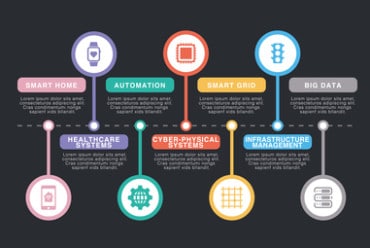
Real-time businesses using cloud can focus on creating outstanding IIoT-powered solutions, leaving all the connectivity woes to the cloud provider.
Cloud pervades the world of business. Whether it’s public, private, or hybrid cloud, whether it’s Infrastructure-as-a-Service (IaaS), Platform-as-a-Service (PaaS), or Software-as-a-Service (SaaS), corporate IT strategists view cloud and cloud services as essential services that enable flexibility and scalability. Those capabilities and others can benefit industrial internet of things (IIoT) applications.
Though applications that leverage industrial internet of things do not necessarily need cloud technologies, there are substantial advantages to integrating cloud with IIoT applications. Cloud delivers remote access, greater levels of data processing power, and better security. With the right networking technologies, individual end points can be located literally anywhere, where they can collect data and transform it to the cloud for near-real-time processing.
With smart decision making, data processing, insights mining, and a wide array of other services all available in the cloud, the emergence of advanced cellular connectivity can enable powerful, new capabilities.
Old models have been stumbling blocks in the path of progress
Historically, though, there’s been a disconnect between IoT and cloud solutions. Early IoT deployments were unable to reach their full potential, incapable of harnessing all that cloud has to offer. That’s because, even though applications, software, and systems were hosted in the cloud, connectivity was still being provided through traditional operator cellular contracts and connections. And that can cause serious bottlenecks, the nemesis of every real-time application.
But with the arrival of pervasive 5G, everything changes. End-to-end, cloud-native network architectures are now easily achieved and financially viable, allowing enterprises to fully utilize the agility, scalability, resiliency, elasticity, and economies of the cloud as the underlying engine that drives a truly connected business at much lower latencies.
The IoT benefits of a cloud-native future
The combination of 5G and IIoT will swiftly transform thousands of enterprises, enabling them to overcome the limitations of traditional connectivity models. Say goodbye to inflexibility, traffic bottlenecks, and the cost structures that prolong the time-to-market and time-to-revenue of IIoT applications. Cloud-native ecosystems instantly transform formerly contorted workflows into plug-and-play environments, eliminating the need for restrictive contracts and hardware-based APIs.
With cloud-native IIoT connectivity on tap, a wide range of benefits can be enjoyed from the outset, including:
- Self-service. You can launch fast without the operational drag due to the usual lengthy administrative burdens. There are no contracts to sign, no tickets to open, and no closed-end commitments. Instead, it’s all taken care of with automated workflows and flexible subscription models.
- Integrations. With cloud-native connectivity, it’s easy to establish connections between devices, applications, and systems. This opens the door to improved operational efficiencies and—better still—tighter security. What’s more, with the right cloud, any IIoT connectivity solution can easily be integrated into your own and many other third-party applications and cloud services.
- Ubiquitous, low latency. If you’re focused on real time, you’ll enjoy a reliable, low-latency connection to a cloud-native, highly reliable core network that spans the globe. You’ll have the ability to select the best local cellular networking option for every use case. Instead of routing data to the cellular operator’s home country, data is routed directly to the closest cloud region. This not only reduces latency but also reduces device energy consumption, extends device battery life, and improves service availability.
- Global cellular network. When you build cloud-native cellular IoT connectivity into your stack, it’s much easier to scale up across national and network borders, and there’s no need to source from different vendors. Even on a per-country basis, multiple networks can be accessed through one global IoT operator, allowing management of all connectivity aspects in a single, central platform.
- Cost-effective. The efficiencies of cloud translate into dramatic cost savings: microservices, network function virtualization, and software-defined networking features can all play a part in keeping costs low. Access to these tools makes networks more responsive and cost-effective to manage, provision, deprovision, and troubleshoot. Not only is responsiveness much improved, but processing power can be allocated on demand. This saves on hardware, storage, energy, and operating costs.
A welcome focus on one’s core competencies
There’s no doubt that end-to-end, cloud-native connectivity can overcome the barriers that remain due to traditional operator contracts and connections. This approach allows business leaders to achieve the fastest time to ROI and to sidestep many of the pitfalls associated with siloed deployments.
Intensive IT administration, skillset-specific maintenance of on-premises servers, networks, and virtualization platforms, as well as operational inefficiencies—all these can all be significantly reduced when you transition from a private, physical server hosted within an organization or data center, towards a comprehensive cloud platform. By alleviating overhead, expenses, and administration pressures, tomorrow’s real-time businesses can focus on creating outstanding IIoT-powered solutions, leaving all the connectivity woes to the cloud provider.




























